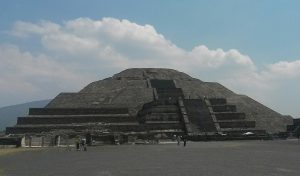What if you found yourself dancing for a purpose much bigger than yourself? Could a dance have the power and the ability to bring back life or rebuild the earth? When people dance for a purpose, others see and listen; but maybe not in the right way. Could the events that occurred at the Battle of Wounded Knee be the cause for such a pivotal moment in history? In this particular case, religion is at the heart of the Sioux Ghost Dance. The power of such a religion is almost unseen in today’s society. Today, when people picture Indians dancing, they picture a massive fire, guns being fired, and many more ritualistic signatures. An extraordinary element of this dance is that it was a religious ceremony, just like taking communion in Church. During this period in history, life was drastically changing for the Sioux Indians. Some of their problems included loss of their land to the whites, scarcity of food, and their freedom being taken away from them. In search of regeneration of the earth and a connection to nature, the Sioux sought to restore things back to earlier times.

The dances that were most important to the Sioux were the Sun Dance and Ghost Dance. The most religious one of the two was the Sun Dance. This was a self-sacrifice ritual with dancing, drums, praying, and self-made cuts to the body. The cuts were made to bring the people closer in prayer and sacrifice for their loved ones. The Ghost Dance was a ritual that led the Battle of Wounded Knee Creek. The purpose of the famous dance was for the earth to restore the earth’s caretakers to their original life of beauty. The Cheyenne, Arapahos, and Kiowas tribes sent emissaries to a man named Wovoka, who said he was the messiah and claimed to be a visionary. This man proclaimed to people that he was shown songs and dances when he had died for some time. He gave the people instructions for the dance.1 Wovoka spoke of the weather and of the future ahead. He also told them to be nonviolent and behave admirably. He changed the tactics of the Indians from war to peace, and he told them that following the orders of the whites would further develop them. The Sioux tribes were influenced by the man and stopped all their warlike ways of life in order to prepare themselves for the happiness to come. The dance was made for peace with the white people; but the Sioux made changes to make it a cleansing ritual for the whites to leave the land. The dance made its mark and made a wave against the white man. 2
The U.S. government broke the Treaty of Fort Laramie and broke up the Great Sioux Reservation of South Dakota into five smaller reservations. The treaty established a relationship between the Sioux, various other tribes inhabiting the Great Plains, and the United States government. The tribes agreed to cease any further violent activity among each other, and the U.S. government would have the ability to develop tracks and roads on their land. They also wanted to break the tribal relationships that were forming during this time. 3 Cavalry had taken Spotted Elk, also known as Big Foot, the chief of the Lakota, to Wounded Knee. The band of Indians had been doing what was asked of them by Wovoka to get the earth back to its full self. On the morning of December 29th, the cavalry tried to collect weapons from the Indians so that no violence would break out. One deaf Lakota warrior refused to give up his rifle. In the scuffle, the firearm had gone off and gun shots filled the morning sky with smoke. Many women and children were killed, making up the majority of the casualties in the massacre.4 Most of the people that participated in the Ghost Dance were not acting out in war-like ways, but despite the purpose of this dance, the government was still very anxious towards the tribes.
The Sioux were such a powerful tribe. They took what was needed and used all that the Great Spirit gave them. These fascinating people were certainly not the “savages” they have been depicted as, but they were people who used all parts of the earth with purpose and meaning. The lives lost at Wounded Knee were a tragedy. This truth of the Ghost Dance and the power of a singular tribe had the influence to show others throughout history that unity can be positive during hard times. The coming together of a people for a spiritual way of life can be meaningful for all that are surrounded by such a force.
- James Mooney, “Ghost Dance – The Messiah Letter from Wovoka,” accessed August 31, 2016, http://www.ghostdance.us/history/history-messiahletter.html. ↵
- Matthew A. Taylor, “‘Contagious Emotions’ and the Ghost Dance Religion: Mooney’s Science, Black Elk’s Fever,” ELH 81, no. 3 (2014): 1055–82. ↵
- Wikipedia contributors, “Ghost Dance,” Wikipedia, The Free Encyclopedia, https://en.wikipedia.org/w/index.php?title=Ghost_Dance&oldid=737020849;33 (accessed September 8, 2016). ↵
- Gregory Michno, “The Indian Trail of Broken Treaties,” Wild West 19, no. 2 (August 2006): 38. ↵



44 comments
Matthew Swaykus
Though this article is very short, it is also very informative and gives much detail into the significance of the dances and the unfortunate consequences of misinterpretation. I’ve stated before how I dislike the use of repetitive questioning, especially in the beginnings of an article, but in this case, it helped the author’s message significantly. He was able to break down the stereotypes associated with Native American traditions and equate them to many of the ideals we believe, such as serving a larger purpose than yourself.
Cameron Lopez
I have had a lesson or two on the wounded knee but it was quite brief and only scratched the surface on the topic. It is crazy seeing the misunderstanding that led to so many deaths mostly consisting of women and children. The government tried to label the natives as savages which was wrong. I know not everything that is taught in school about Indians is not true, but I thought its school they know their history but apparently it goes deeper than that.
Noah Bolhuis
Learning more about the people that lived here before us has been a big interest of mine for a very long time. Growing up around the former Cahokia, among other tribes, it has always been a big interest to e. Knowing that not everything taught in schools about Indians are true, I always came into those classes with skepticism and always made sure that I did my own research. The Sioux and their dances were something I have been unfamiliar with, and I enjoyed reading your article.
Tyanne Pearcy
I have heard of The Battle of the Wounded Knee but never knew the history behind it. It is crazy hoe misunderstanding led to so many deaths mostly consisting of women and children. It was very upsetting that the government tried to depict the Natives as savages. The most interesting part was the dance with the Great spirit that they used in battle.
Luke Lopez
This was a very interesting article on the Sioux tribe, and how their dancing influenced their lives and their relationships with other people. I have never heard of the different types of dances that the Sioux tribe performs, but I now know that these dances allowed the Sioux to either engage in religious activity, or to hope for peace with the white people.
Marina Castro
Very interesting topic! I love to read articles about cultures like this one because there is not much information about it. I am glad that people in the comments also enjoyed reading about the Sioux as much as I did. I particularly enjoyed reading about their dances and other rituals that differ them from other native cultures. Great job with this article!
Raymond Nash Munoz III
The introduction to this article was very well structured. In fact, it got me thinking of a movie where a guy tried to challenge another to a “dance off to save the universe,” but this was more for comedic purposes, opposed to the Sioux Indians dancing to express their culture. Dancing has never been a major interest of mine, but I have often heard that dance is another form of language and that it is spoken in many different ways, just as any other language. So, I believe that the author is trying to convey the fact that there is more to dancing then meets the eye, literally.
Noah Bolhuis
Native American traditions have always seemed to peak my interest. Some thoughts that come to mind are if any of them were influenced by the spread of European cultures, how long they lasted, if they are still doing them, and how accurate were they. It is a well known stereotype that natives were always super respectful to the earth and nature, and while largely true, there were some tribes that would destroy everywhere they were, or burn down entire forests to be able to hunt, or to lure prey animals out for easy hunting. So, obviously some thoughts about their traditions were not entirely true.
Honoka Sasahara
It was so interesting to learn the Sioux tribe and their dances that I have never heard before. The most surprising one is that they hurt themselves when they danced the Sun dance. I didn’t know such kind of ritual. I thought that there would be a lot of cultures that I don’t know in the world like that of the Sioux, so I’d like to study them more.
Lamont Traylor
Native people have always interested me with the methods and traditional practices they do to make certain things happen. I just wonder where they got these ideas from and how they are performed. Indians such as the Sioux people will do dances to bring prosperity and even for rain to come during a drought. In the article they show them doing dances to use in battle.